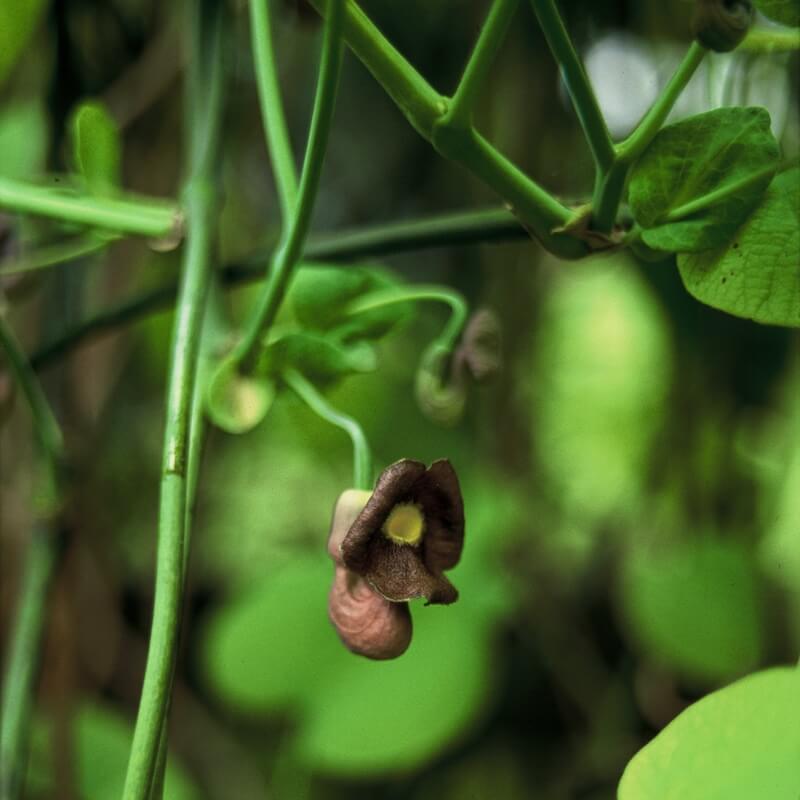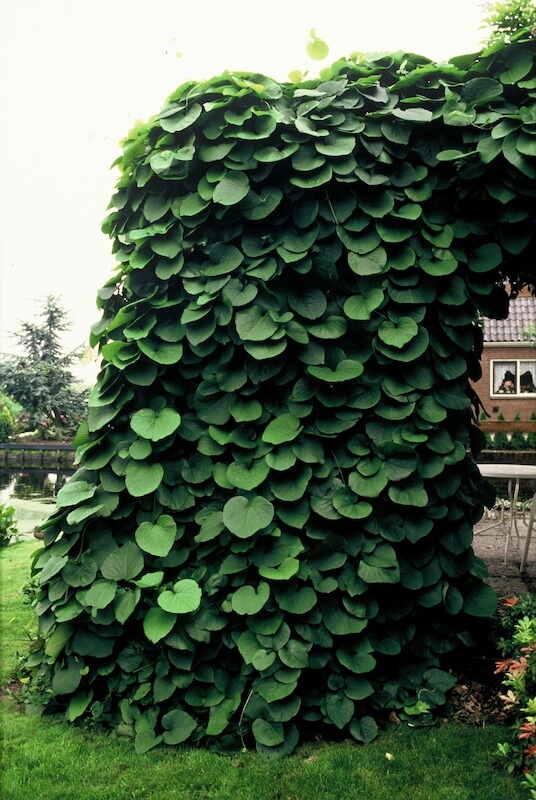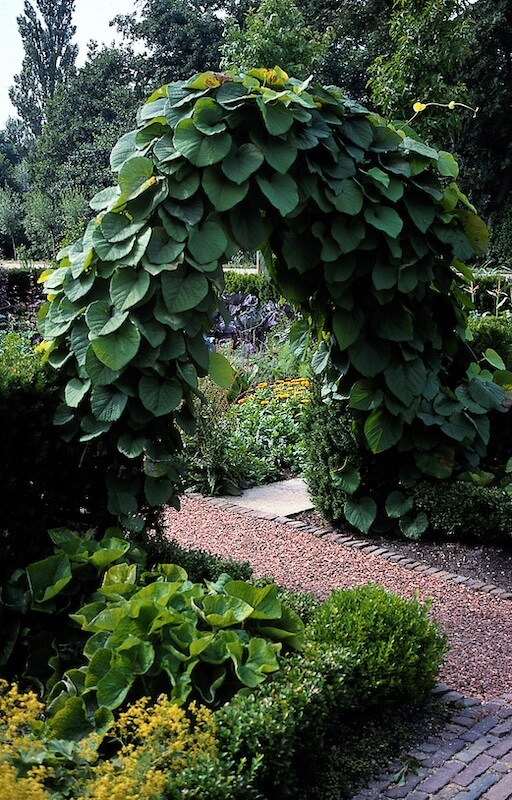
Position
- Prefers partial shade but will grow in full sun if the soil stays moist
- Ideal for covering walls, fences, pergolas, or large trellises—needs sturdy support due to its vigorous nature
- Best in a sheltered, wind-protected site to prevent wind scorch and damage to large leaves
Hardiness
- Hardy down to around –20°C (–4°F)
- Well suited to most UK regions, withstanding typical winters
Soil
- Thrives in deep, fertile, moist but well-drained soil
- Prefers soil improved with plenty of compost or well-rotted manure, especially at planting time, to boost vigour and moisture retention
- Performs poorly in shallow, dry, or very poor soils
- Tolerates acid, neutral, or alkaline soils
- Highly adaptable, provided the soil has plenty of organic matter and doesn’t dry out
- Grab a soil test kit and ensure the perfect conditions for growth
Height
- Can reach 8–10 metres (26–33 feet) in 5–10 years with good support and conditions
- Rapid-growing deciduous climber, soon forming a lush screen
Seasons of Interest
- Foliage: Very large, heart-shaped green leaves provide impressive, dense coverage from spring to autumn
- Autumn Colour/Variegation: Leaves may turn yellow in autumn before falling; no variegation
- Flowering: Unique, pipe-shaped yellowish-green to purplish-brown flowers appear in late spring to early summer (May to June), often hidden among foliage
Additional Notes
- Prune in late winter or early spring to restrict size and remove any dead or damaged wood—tolerates hard pruning if necessary
- Mulch annually in spring with compost or leaf mould to retain soil moisture and boost plant health
- Water well during dry periods, especially in summer and for young vines
- Pest and disease resistant; virtually trouble-free once established
- Suitable for large gardens due to its size and vigour; not suited to small spaces
- Deciduous, so the screening effect is seasonal
Aristolochia macrophylla – A Climber Like No Other
Looking for a bold, unusual climber that brings real character to your garden? Aristolochia macrophylla, also known as Dutchman’s pipe or pipevine, might just be the one. With its huge, heart-shaped leaves, quirky pipe-shaped flowers, and dense coverage, this vigorous deciduous climber is a real showstopper. Whether you want to green up a bare wall, cover an old fence, or bring architectural interest to a pergola, this plant will rise to the challenge.
What Makes Aristolochia macrophylla a Great Plant for Your Garden?
Aristolochia macrophylla is a vigorous deciduous climber known for its large, heart-shaped leaves and unusual flowers that resemble Dutch smoking pipes. Native to the southeastern and eastern United States, it thrives in UK gardens when given the right conditions.
This climber isn’t just about quirky blooms. Its dense foliage brings a lush, almost tropical feel to the garden, especially during summer. The thick leaf cover also creates shade, making it perfect for screening, privacy, or cooling a sunny spot. It’s a natural choice if you want to cover an arbour or trellis quickly.
Once established, this plant can reach impressive heights. It’s ideal for vertical gardening and works well in urban gardens where ground space is limited—a true star in any shady or partially shaded corner.

Where Should You Plant Aristolochia macrophylla?
This climber enjoys a spot where they can stretch out and climb. Plant it near a trellis, fence, or sturdy arbour that can support its weight as it grows. The woody stems twine naturally around supports, making training easy.
Although it prefers rich, moist soils, Aristolochia macrophylla will tolerate most well-drained soil types as long as they’re not dry. It’s not a fan of dry soils or drought, so avoid overly sandy or exposed sites.
For best results, choose a position with partial shade or full sun. In full sun, you’ll get quicker growth, while in partial shade, the foliage tends to look fresher and lasts longer into autumn. Either way, this plant makes a significant visual impact.
Does Aristolochia macrophylla Grow in Full Sun or Shade?
Aristolochia macrophylla is surprisingly adaptable. It grows well in full sun but also performs in partial shade. That flexibility makes it a useful choice in many gardens, especially those with mixed light conditions.
In full sun, the plant produces dense foliage and vigorous stems. It’ll cover large areas quickly, ideal for screening or greening walls. However, you’ll need to water more during hot spells to keep the soil moist.
In partial shade, the heart-shaped leaves stay lush and deep green throughout summer. The plant’s dense foliage makes it an excellent choice for cooling spaces or providing shade over pergolas and patios. It’s tolerant of dappled conditions under trees or along north-facing walls.

What Do the Flowers of Aristolochia macrophylla Look Like?
This plant’s flowers are unlike anything else in the garden. Known as Dutchman’s pipe, the blooms resemble old-fashioned smoking pipes. Each flower has a curved calyx with a wide mouth and three brownish-purple lobes.
The flowers appear in early summer and are usually greenish or yellowish-green, often mottled with yellow and purple. They’re not large or showy, but they do carry an unusual fragrance. Some gardeners describe the scent as musty, which attracts insects for pollination.
Though the flowers are inconspicuous compared to the foliage, they add unique interest. These quirky blooms make a great talking point and add to the plant’s charm.
How Big Will Aristolochia macrophylla Grow?
Aristolochia macrophylla is a vigorous climber with a strong growth habit. Under good conditions, it can grow 8–10 metres (26–33 feet) tall and 3–5 metres (10–16 feet) wide. It’s a true architectural plant that can quickly cover large vertical spaces.
This makes it ideal for screening or softening large structures in the garden. It’s excellent for wrapping around arbours, fences, or even unsightly sheds. Given a few years, it forms a lush green wall with dense foliage and a real sense of permanence.
The plant’s woody stems and twining nature enable it to climb steadily without requiring constant tying in. It’s a reliable, low-fuss option if you want to add instant impact.
How Do You Prune Aristolochia macrophylla?
Prune Aristolochia macrophylla in late winter to control size and shape. This climber can grow quite large, so regular pruning helps keep it neat and encourages bushy growth. It also helps remove old or straggly branches.
Cut back long or tangled stems in winter, before the plant breaks dormancy. Focus on shaping the climber to suit its support structure. Remove any dead or damaged wood at the same time.
If it becomes too vigorous or sprawls too far, you can prune it harder to reduce its size. This climber tolerates a good cut back, especially when established. Always prune above healthy buds to encourage new shoots in spring.
What Kind of Soil Does Aristolochia macrophylla Prefer?
This plant grows best in fertile, well-drained soil that holds some moisture. It thrives in soil rich in organic matter, such as garden compost or well-rotted manure, around its base.
Aristolochia macrophylla prefers moist woods in its native habitat, so try to recreate similar conditions. If your soil is dry or sandy, enrich it with organic matter before planting. Add organic matter and mulch with compost to help retain moisture.
While the plant can tolerate various soil types, it’s intolerant of dry conditions. During dry spells, provide it with regular water to support its growth. Avoid planting in dry soils or exposed areas that become extremely hot in the summer.
Is Aristolochia macrophylla Hardy in the UK?
Yes, Aristolochia macrophylla is hardy in most parts of the UK. It can withstand temperatures as low as around –20°C (–4°F), making it suitable for outdoor growing year-round.
In colder areas, you may notice some dieback during particularly harsh winters. However, the plant usually recovers well in spring, sending up strong new shoots. Mulch around the base in autumn to help protect the roots from frost.
Although it loses its leaves in winter, the woody stems remain. Come spring, the plant bursts into growth with fresh, vibrant foliage. Its hardiness and vigour make it a dependable choice for a range of UK gardens.
What Is the Foliage Like on Aristolochia macrophylla?
Foliage is one of this climber’s biggest strengths. The large, deep green, heart-shaped leaves grow densely along the stems. They can be 20–30 cm long, creating bold texture and colour.
This dense foliage brings an almost tropical feel to the garden. It provides cooling shade and shelter for wildlife. The lustrous leaves look especially attractive in contrast with other climbers or flowering plants.
The dense foliage also helps the plant perform as an excellent privacy screen. Whether you’re hiding an old fence or creating a green wall, this climber does the job beautifully.
Is Aristolochia macrophylla Good for Wildlife?
Aristolochia macrophylla plays an important role in supporting insects, especially in its native range. In the eastern United States, it’s the larval host plant for the pipevine swallowtail butterfly. While this butterfly doesn’t live in the UK, the plant can still provide shelter and nectar for other garden insects.
Its pipe-shaped flowers attract pollinators through scent rather than colour. Insects enter the calyx and help with pollination as they explore its chambers. The dense foliage also offers cover for small birds and beneficial insects.
In a wildlife-friendly garden, this climber earns its keep. Add it to a mixed planting scheme with nectar-rich flowers, and you’ll support pollinators while enjoying year-round structure and interest.
What Should You Know Before Buying Aristolochia macrophylla?
Before purchasing Aristolochia macrophylla, ensure you have the ideal location for it. It’s a vigorous plant that needs space and support. Check your garden centre or specialist nursery for healthy, well-rooted young plants.
Look for sturdy stems and vibrant leaves when choosing your vine. The plant may die back slightly in winter, so it’s best to plant in spring or early summer when growth is active.
If planting near a wall, add a trellis or wires to guide the stems. Dig a generous hole and enrich the soil with well-rotted garden compost. Water well after planting and mulch annually to keep roots cool and moist.
From Darren’s Patch
Although I’m not currently growing Aristolochia macrophylla, it’s one of those plants I keep coming back to when planning bold, vertical features. There’s just something captivating about those huge, heart-shaped leaves and the oddball flowers — they add real character to a garden. If you’ve got a wall or pergola crying out for structure and shade, this climber does the job beautifully. It’s not for small spaces or dry soils, but in the right spot, it rewards you with dramatic coverage and a lush, almost tropical feel. If I had a north-facing fence that needed softening, I’d be tempted to give this one pride of place.
![]()
Key Points to Remember:
- Aristolochia macrophylla is a vigorous deciduous climber with heart-shaped leaves and pipe-shaped flowers
- Ideal for full sun or partial shade and grows well in rich, well-drained, moist soils
- It thrives in UK gardens and tolerates temperatures down to –20°C (–4°F)
- Flowers appear in early summer and attract insects with their unusual fragrance
- Dense foliage offers screening, shade, and structure in the garden
- Prune in late winter to manage growth and encourage bushy stems
- Plant near trellises, fences, or arbours for the best support and impact
- Enrich the soil before planting and mulch with garden compost or manure around the base
- A good plant for insect-friendly gardens and vertical gardening schemes
- Check local garden centres or nurseries in spring for the best time to buy Aristolochia macrophylla
This bold climber may not be the most common choice for the garden, but its impact is unforgettable. If you’re looking to bring structure, interest, and a touch of the unusual to your garden, Aristolochia macrophylla is well worth growing.
Explore our full collection of planting guides for expert advice on climbers and wall shrubs.
Want to learn about other climbers? Read about Hedera colchica Sulphur Heart here.

Frequently Asked Questions
Q: What is Aristolochia macrophylla, and why is it known as Dutchman’s pipe?
A: Aristolochia macrophylla is a vigorous deciduous climber, commonly referred to as Dutchman’s pipe due to its unusual pipe-shaped flowers that resemble old-fashioned Dutch smoking pipes. A member of the Aristolochiaceae family, this woody vine is prized for its dense foliage of large, heart-shaped leaves and its ability to cover arbours, trellises, and fences quickly. While the flowers are small and greenish-yellow with brownish-purple lobes, their unusual form adds a quirky charm. Native to the eastern United States, Aristolochia macrophylla is also known as a larval host for the pipevine swallowtail butterfly, making it beneficial for wildlife gardens.
Q: Is Aristolochia macrophylla suitable for UK gardens?
A: Yes, Aristolochia macrophylla is well-suited to UK gardens, especially in sheltered spots. It is hardy and can withstand temperatures as low as –20°C (–4°F), making it resilient through most UK winters. This deciduous climber thrives in well-drained, yet moist and rich soil, and adapts well to partial shade or full sun. It is ideal for covering walls, trellises, or arbours where its dense, heart-shaped foliage offers dramatic summer coverage. It’s best grown in larger spaces where its vigorous growth habit can be appreciated and managed without overwhelming nearby plants.
Q: What growing conditions does Aristolochia macrophylla prefer?
A: Aristolochia macrophylla prefers moist but well-drained, fertile soil and thrives in partial shade to full sun. It is intolerant of dry conditions, so consistent moisture is essential, particularly during its establishment period. This deciduous climber thrives in rich, loamy soil with a high organic matter content. While it tolerates sun, it particularly excels in dappled or light shade, where the large, deep green, heart-shaped leaves retain their colour and vigour. Avoid planting it in exposed, wind-prone sites as this can lead to leaf scorch or stem damage.
Q: How tall does Aristolochia macrophylla grow and how fast?
A: Aristolochia macrophylla is a vigorous climbing vine that can quickly reach heights of 10–15 metres (30–50 feet) under ideal conditions. It twines around supports with woody stems, making it suitable for covering large vertical structures, such as arbours, fences, and pergolas. Its rapid growth means it can provide substantial coverage within just a few seasons, especially when planted in nutrient-rich soil with adequate water and support. Pruning can help control its size and shape, particularly in more compact gardens or where spreading must be limited.
Q: Does Aristolochia macrophylla flower, and what do the blooms look like?
A: Yes, Aristolochia macrophylla produces unusual pipe-shaped flowers that bloom in late spring to early summer. These flowers are greenish to yellowish-green, often mottled with purple, and feature a curved calyx with three brownish-purple lobes that resemble Dutch smoking pipes. Though not showy in the traditional sense, the flowers are highly distinctive and carry an unusual scent that attracts pollinating insects. They are somewhat hidden beneath the foliage, making them a delightful surprise upon close inspection. The primary ornamental feature, however, remains the dramatic foliage.
Q: How do I prune Aristolochia macrophylla?
A: Prune Aristolochia macrophylla in late winter or very early spring before new growth begins. This deciduous climber responds well to pruning, which helps manage its vigorous habit and encourages dense, healthy foliage. Remove any dead, damaged, or overly tangled stems to maintain airflow and structure. You can also cut back overgrown stems to control spread and encourage fresh growth from the base. Use sharp, clean tools and aim to shape the plant to suit your garden structure—whether it’s an arbour, trellis, or wall.
Q: Is Aristolochia macrophylla good for wildlife?
A: Absolutely. Aristolochia macrophylla is a valuable addition to wildlife-friendly gardens. It is a known larval host plant for the pipevine swallowtail butterfly in its native range, although this butterfly is not found in the UK. Nevertheless, the dense foliage provides shelter for insects and nesting birds, and its unusual flowers attract pollinators. By planting this climber, you’re helping to create a more biodiverse environment, particularly in gardens that emphasise natural planting styles or support pollinators.
Q: Can Aristolochia macrophylla grow in shade?
A: Yes, Aristolochia macrophylla is well-adapted to shade, especially partial or dappled shade. It thrives in woodland-style settings and is perfect for covering shaded structures where other climbers may struggle. The large, heart-shaped leaves remain vibrant in low light, forming a dense green screen that adds structure and lush texture. While it can tolerate full sun in cooler regions, excessive heat or exposure can result in leaf scorch. Shade or partial shade offers the best results, especially when paired with moist, rich soil.
Q: How should I feed and mulch Aristolochia macrophylla?
A: Feed Aristolochia macrophylla in spring with a balanced, slow-release feed suitable for flowering climbers. This supports healthy foliage and encourages steady growth throughout the season. Additionally, mulch annually with well-rotted garden compost or organic matter around the base to retain soil moisture and improve structure. Mulching also suppresses weeds and regulates soil temperature. Please don’t allow mulch to come into direct contact with the stems. In dry periods, water the plant regularly to maintain its vigour, particularly during its first couple of growing seasons.
Q: Where can I buy Aristolochia macrophylla?
A: Aristolochia macrophylla is available at many well-stocked garden centres across the UK and through reputable online plant nurseries. When purchasing, look for healthy specimens with strong stems and fresh foliage. As a specialist climber, it may not always be in stock year-round, so spring and early summer are often the best times to find it. If shopping online, ensure the supplier provides clear growing information and check reviews before ordering. This climber is a standout choice for dramatic foliage and fast coverage in the garden.
